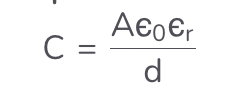Capacitance
1/53
There's no tags or description
Looks like no tags are added yet.
Name | Mastery | Learn | Test | Matching | Spaced |
|---|
No study sessions yet.
54 Terms
What are they used to do?
Store energy in circuits, commonly for backup release of energy if the power fails
How do they work?
Storing electric charge, which creates build up of electric potential energy
What are they made of?
Two conductive plates connected to a voltage supply and there is a commonly a dielectric (poor conductor of electricity) in between plates to ensure charge doesn’t flow across them
circuit symbol:
and marked with the value of their capacitance

Capacitance definition:
The charge stored per unit potential difference (between the plates)
The greater the capacitance, the ____ the charge stores in the capacitor
greater
Units the units of C=Q/V
C- Capacitance (F)
Q- Charge stored (C)
V- Potential difference across capictor plates (V)
Units for capacitance
Farad (F)
When using capacitance equation were are units from?
Q- is charge on the plates (not charge on capacitor itself, its charge on plates)
V- potential difference across the capacitor
What does capacitance equation show?
An object’s capacitance is ratio of charge stored by the capacitor to the potential difference between the plates
capacitors are charged by a _______
power supply
How does it works when charging up?
Plate connected to pos terminal pulls electrons from it so becomes pos charged.
Electrons travel around circuit are pushed from neg terminal and are pushed onto the other plate so it becomes negatively charged.
As neg charge builds, fewer electrons are pushed onto plate due to electrostatic repulsion from electrons already on plate. When no more electrons can be pushed on to plate, charging stops
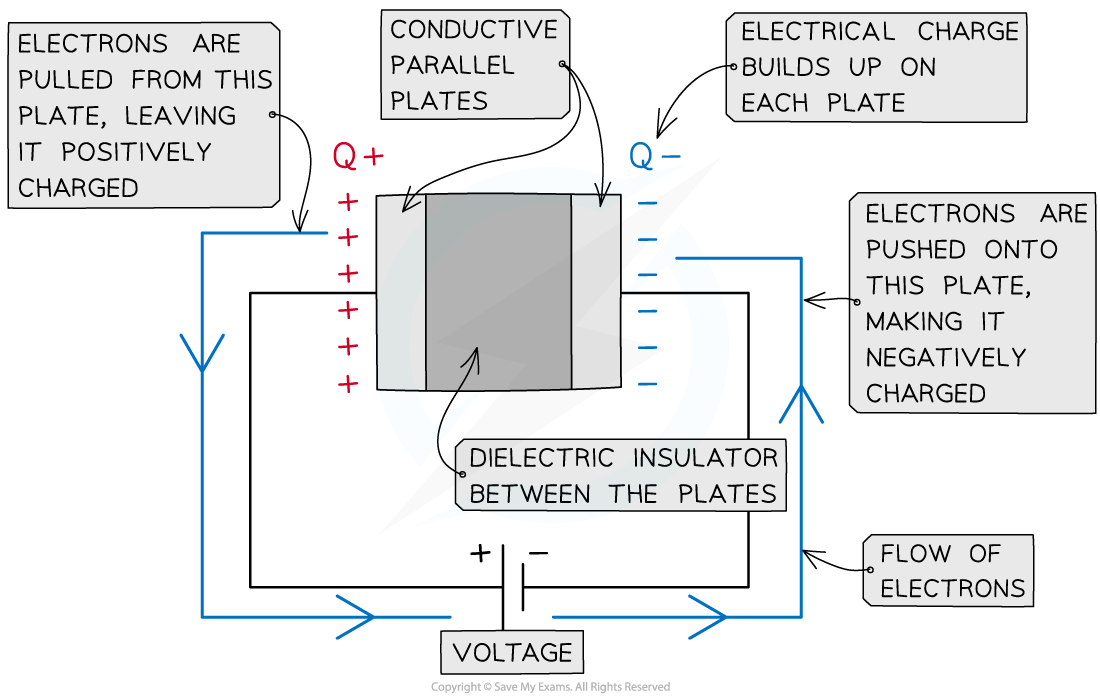
How current changed when charging and why, when charging up?
Large and gradually falls to 0- decreases exponentially
as electrons stop flowing through the circuit
What is potential difference change when charging up?
As equal and opposite charge builds up on each plate, the potential difference across plate slowly increases until it is the same as the power supply
How does charge change when charging up?
Charge of plates slowly increases until its max charge defined by the capacitance of the capacitor
How to capacitors discharge?
Through a resistor with no power supply present. Achieved by moving a switch that connects the capacitor between power supply and a resistor
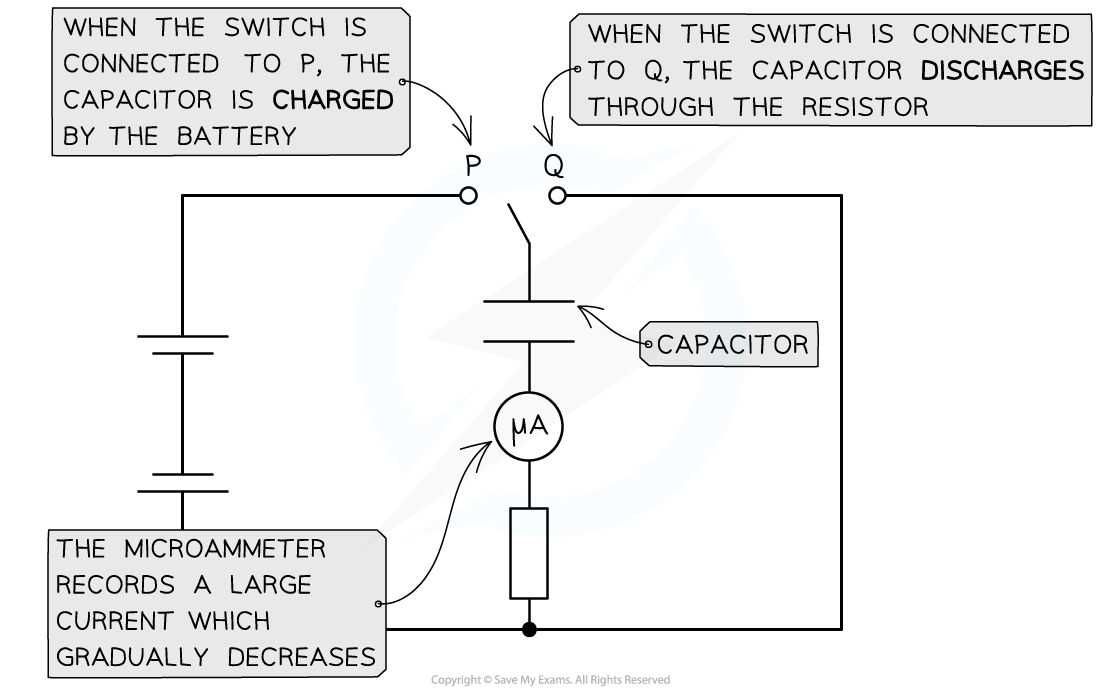
Where do electrons move when they discharge?
Flow back from negative plate to pos plate until there are an equal n on each plate and no potential difference between them
How current changes during discharge?
Current is large at start (but in opposite direction to when it was charging) and gradually falls to zero
How does current, p.d. and charge change when capacitor discharges?
Exponentially
What does this mean?
Rate at which the current, p.d of charge decreases is proportional to amount of current, p.d or charge left
If 2 capacitors are connected in series, with a potential difference across them what happens to capacitance?
As p.d is shared between all components so if capacitors store the same charge on their plates but have diff p.ds, so p.d. across C1 is V1 and C2 is V2
So..
V= V1 + V2
Sub in to V=Q/C
V= Q/C total
so
Q/ C total = Q/C1 + Q/C2
Current is same in all components, the charge is the same through each capacitor and cancels out
1/Ctotal = 1/C1 + 1/C2 …
Capacitors in parallel?
Current is split across each junction, the charge stored on each capacitor is different, charge on C1 is Q1 and C2 is Q2.
Q total =Q1 + Q2
As
Q total= C total x V
C total X V= (C1 + C2)V
P.d is same in all components so cancels out
So combined capacitance is
C total= C1+ C2 ….
What happens when the power supply pushes electrons from pos to neg plate?
Does work on the electrons and the electrical energy becomes stored on the plates
charge Q on the capacitor is directly proportional to …….
its p.d.
What is the area under a potential difference v Charge graph mean?
Electrical (potential) energy stored in capacitor
How to charge a capacitor?
Using a power supply
As the negative charge builds up, fewer electrons are pushed onto the plate due to _____________ from the electrons already on the plate
electrostatic repulsion
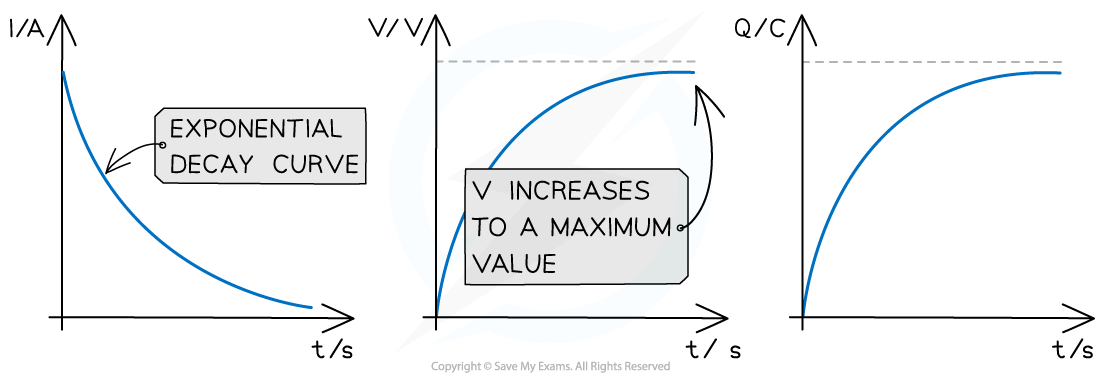
charging graphs
key features of charging graphs:
P.d and charge against time have identical shape
Current against time graph is an exponential decay curve
initial value of current starts on y-axis and decreases exponentially
initial value of p.d and charge start at 0 up to max value
how discharging works?
electrons now flow back from the negative plate to the positive plate until there are equal numbers on each plate and no potential difference between them
discharging graphs?

key features of discharge graphs:
shape of current, p.d. and charge against time graphs are identical
each graph shows exponential decay curves with decreasing grad
initial values (I0, V0 and Q0) start on y axis and decrease exponentially
How does rate of capacitor discharging change depending on resistance?
High resistance= current decrease and charge will flow from capacitor plates more slowly, meaning it will take longer to discharge
Low= current increase and charge will flow from capacitor plates quickly, meaning it will discharge faster
Investigating charge/ discharge of capacitor
Set the battery pack to a potential difference of 10 V and use a 10 kΩ resistor
Note: The capacitor should initially be fully discharged
Charge the capacitor fully by placing the switch at point X
The voltmeter reading should read the same voltage as the battery (10 V)
Move the switch to point Y
Record the voltage reading every 10 s down to a value of 0 V. A total of 8-10 readings should be taken
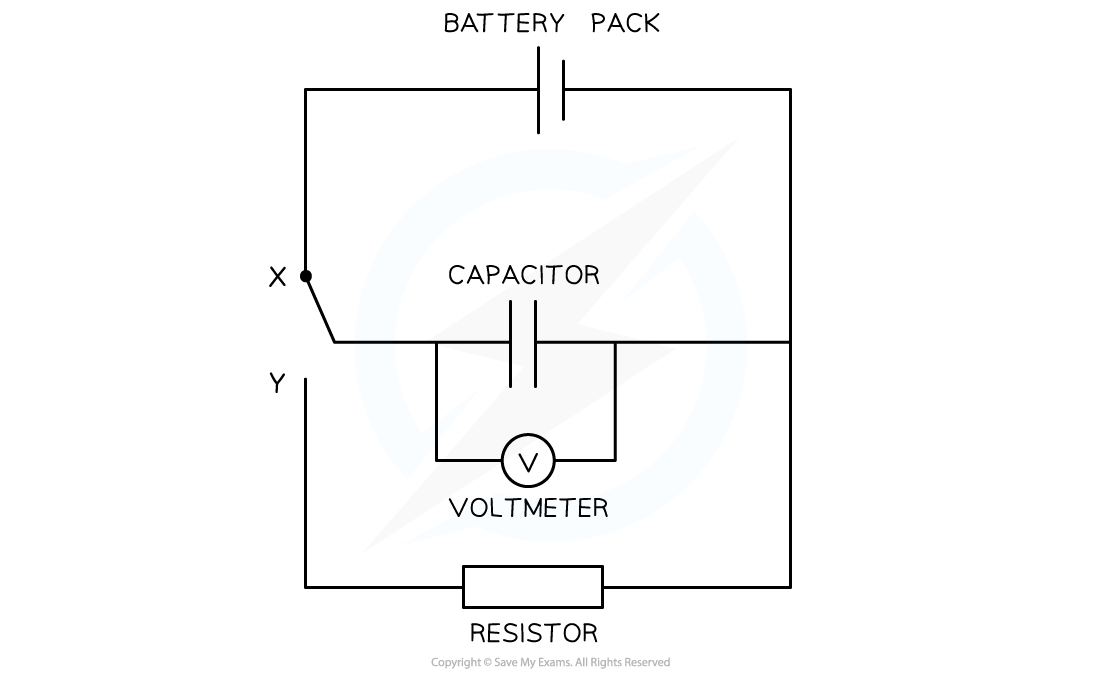
How to set up graph of results:
y = mx + c
y = ln(V)
x = t
gradient = -1/RC
c = ln(V0)

Errors:
Systematic Errors:
If a digital voltmeter is used, wait until the reading is settled on a value if it is switching between two
If an analogue voltmeter is used, reduce parallax error by reading the p.d. at eye level to the meter
Make sure the voltmeter starts at zero to avoid a zero error
Random Errors:
Use a resistor with a large resistance so the capacitor discharges slowly enough for the time to be taken accurately at p.d. intervals
Using a datalogger will provide more accurate results for the p.d. at a certain time. This will reduce the error in the speed of the reflex needed to stop the stopwatch at a certain p.d.
The experiment could be repeated by measuring the time for the capacitor to charge instead
Definition of time constant is:
Time taken for the charge, current or voltage of a discharging capacitor to decrease to 37% of its original value
Definition time constant for charging a capacitor:
Time taken for charge or voltage of a charging capacitor to rise to 63% of its max value
Where is value of 37% from
1/e
τ
TIME CONSTANT measured in seconds
from 37% x by original value (L0, Q0, V0)
time to half, t1/2 (half-life) for a discharging capacitor is:
time taken for the charge, current or voltage of a discharging capacitor to reach half of its initial value
can also be written in terms of the time constant, τ:
t1/2 = ln(2) τ = 0.69RC
The current at any time is directly proportional to the ….. in the capacitor and the charge across the parallel plates
p.d.
This exponential decay means that no matter how much charge is initially on the plates, the amount of time it takes for that charge to halve is the same

What does this show?
the smaller the time constant τ, the quicker the exponential decay of the current when discharging
When a capacitor is charging, the way the charge Q and potential difference V increases stills shows exponential decay
Over time, they continue to increase but at a slower rate

What does this equation mean?
Equation when capacitor is charging
For charge and voltage

What ___ means?
Q = charge on the capacitor plates (C)
Q0 = maximum charge stored on capacitor when fully charged (C)
e = the exponential function
t = time (s)
RC = resistance (Ω) × capacitance (F) = the time constant τ (s)
charging equation for the current I is the same as its discharging equation since the current still decreases exponentially
Time constant
time taken for the charge of a capacitor to decrease to 1/e of its original value


how??
| ||
| ||
|
what?
| ||
| ||
|
where?
